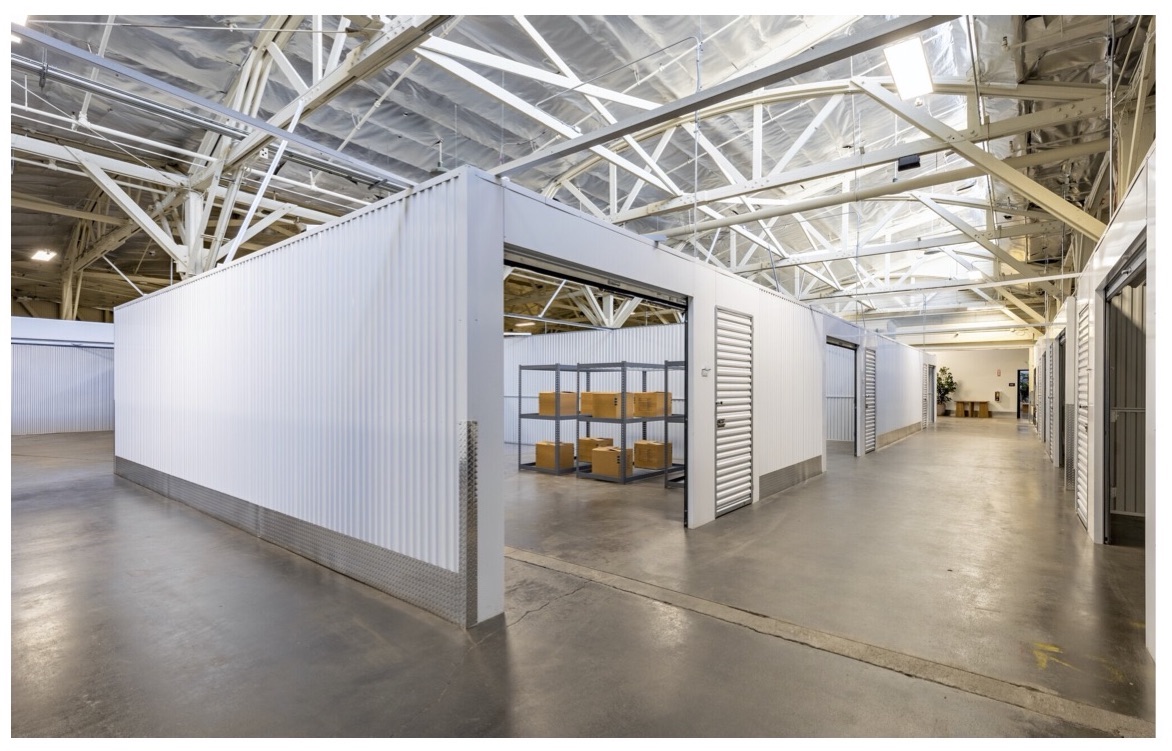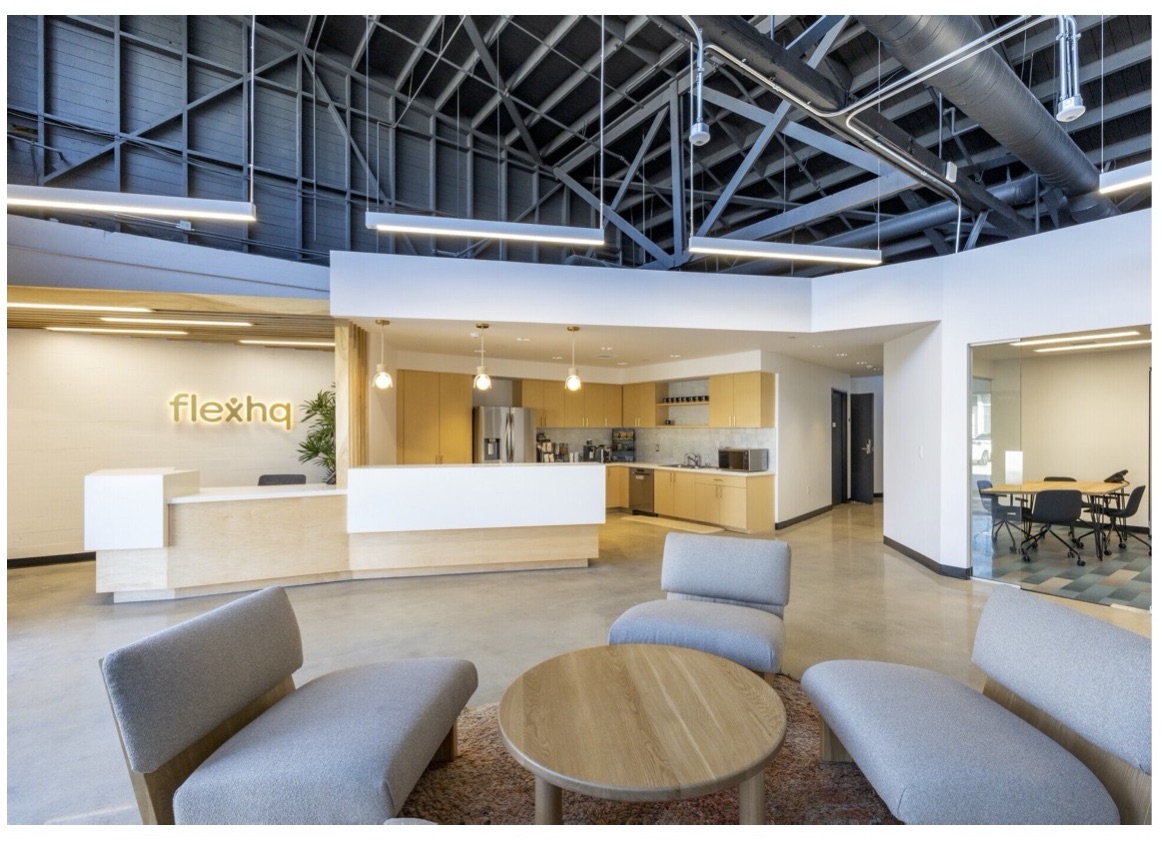The design firm Ware Malcomb has partnered with FlexHQ, a Los Angeles-based firm offering cowarehouse leasing solutions, to create a scalable workspace that emphasizes leasing flexibility and higher-quality and environmentally friendlier amenities than aren’t commonly found in this building type, say representatives from both companies.
Late last year, FlexHQ—which is backed by the self-storage company Storage Etc. and real estate developer KOAR International—opened its first location, a 50,000-sf warehouse in Los Angeles that offered warehouse and office spaces ranging from 300 to 3,000 sf. Sometime this summer, FlexHQ is scheduled to open a 75,000-sf cowarehouse in Denver with 67 warehouse spaces of varying sizes, along with 21 private offices, and amenities that include high-speed internet, conference rooms, daily shipping and receiving services, a communal kitchen, a professional photo studio, and podcast studio.
The Denver Post reported that FlexHQ paid $10.8 million to acquire the Denver building in September 2022. FlexHQ intends to own its cowarehouses as it grows. FlexHQ’s immediate expansion plans call for opening cowarehouses in Salt Lake City and Dallas, according to Laurent Opman, the company’s cofounder, in response to emailed questions from BD+C. The company is also exploring growth opportunities in Florida and Tennessee.
Opman says that FlexHQ was attracted to Ware Malcomb’s “deep experience” in industrial and warehouse architecture, its nationwide offices, and its close relationship with CBRE, which is providing construction management services for FlexHQ’s projects. Other members of the Building Team on the Denver project are the GC Alcorn Construction, and a local architect Intergroup Architects.
A sustainable interior design for cowarehouse facility

FlexHQ has entered what can best be described as a crowded but fragmented competitive field, led by Cubework, with around 80 locations nationwide and in Canada, and several other locations scheduled to open soon, according to its website. Saltbox, with 10 locations, touts is cowarehouses as “built by entrepreneurs for entrepreneurs.”
By offering space options, FlexHQ is appealing to startups and smaller businesses that are seeking lease flexibility as their companies’ needs change. FlexHQ, says Opman, is “rooted in the experience of its founders” in commercial real estate acquisition and development, with an emphasis on adaptive reuse. Opman adds that FlexHQ is focused on “delivering the best locations, high quality improvements, and the highest level of operation and user’s experience.”
In addition to EV charging stations, Ware Malcomb’s sustainable design for the Denver location includes upgrading and retrofitting the building’s entire lighting system, and using recycled building materials, energy saving fixtures, and green technologies that reduce the facility’s carbon footprint.
What’s different from competitors’ cowarehouses, says Hardev, is an “elevated design” with natural materials “to bring warmth to a space that is generally seen as a stark and cold environment.” Branding and graphics for wayfinding provide a “curated cowarehousing space where businesses feel a sense of community as well as foster creative energy.”
The communal experience that FlexHQ is striving to create might present price barriers for some tenants. Opman told Bisnow.com that the average rent for space in its Los Angeles facility is about 2.5 times higher than the average warehouse space, and twice what self-storage would charge.
Combining warehouse and office spaces also presents some design and engineering challenges, says Bhavini Hardev, Ware Malcomb’s Studio Manager. She explains that acoustics, functionality, user friendliness, and security are the focal points of the layout whose quiet office spaces must coexist with noisier loading and storage areas. The design takes these adjacencies into account with “strategic placement” of rooms and materials.
Related Stories
| Aug 11, 2010
New York Mayor Bloomberg opens nation's first multi-story green industrial facility and announces new green manufacturing plant at Brooklyn Navy Yard
Mayor Michael R. Bloomberg, Deputy Mayor for Economic Development Robert C. Lieber, and Brooklyn Navy Yard Development Corporation Chairman Alan Fishman and President Andrew H. Kimball today opened the Perry Avenue Building, the nation's first multi-story green industrial facility at the Brooklyn Navy Yard. Mayor Bloomberg also announced the creation of Duggal Greenhouse, a 60,000-square-foot LEED Platinum certified facility.
| Aug 11, 2010
ASHRAE introduces building energy label prototype
Most of us know the fuel efficiency of our cars, but what about our buildings? ASHRAE is working to change that, moving one step closer today to introducing its building energy labeling program with release of a prototype label at its 2009 Annual Conference in Louisville, Ky.
| Aug 11, 2010
USGBC considering LEED for Data Centers program
In a blog post this morning on Earth2Tech, Justin Moresco writes that the U.S. Green Building Council is giving strong consideration to developing a version of its LEED green building rating system for data centers.
| Aug 11, 2010
10 tips for mitigating influenza in buildings
Adopting simple, common-sense measures and proper maintenance protocols can help mitigate the spread of influenza in buildings. In addition, there are system upgrades that can be performed to further mitigate risks. Trane Commercial Systems offers 10 tips to consider during the cold and flu season.
| Aug 11, 2010
Jacobs, Holder Construction top BD+C's ranking of the nation's 50 largest industrial building contractors
A ranking of the Top 50 Industrial Contractors based on Building Design+Construction's 2009 Giants 300 survey. For more Giants 300 rankings, visit http://www.BDCnetwork.com/Giants
| Aug 11, 2010
AECOM, Arup, Gensler most active in commercial building design, according to BD+C's Giants 300 report
A ranking of the Top 100 Commercial Design Firms based on Building Design+Construction's 2009 Giants 300 survey. For more Giants 300 rankings, visit http://www.BDCnetwork.com/Giants
| Aug 11, 2010
Turner Building Cost Index dips nearly 4% in second quarter 2009
Turner Construction Company announced that the second quarter 2009 Turner Building Cost Index, which measures nonresidential building construction costs in the U.S., has decreased 3.35% from the first quarter 2009 and is 8.92% lower than its peak in the second quarter of 2008. The Turner Building Cost Index number for second quarter 2009 is 837.
| Aug 11, 2010
AGC unveils comprehensive plan to revive the construction industry
The Associated General Contractors of America unveiled a new plan today designed to revive the nation’s construction industry. The plan, “Build Now for the Future: A Blueprint for Economic Growth,” is designed to reverse predictions that construction activity will continue to shrink through 2010, crippling broader economic growth.







